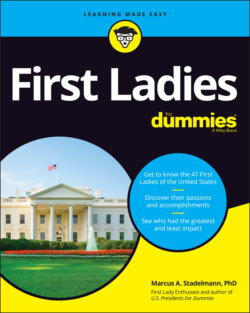Читать книгу First Ladies For Dummies - Marcus A. Stadelmann, Marcus A. Stadelmann PhD - Страница 70
Blazing the trail for future First Ladies
ОглавлениеAfter Dolley Madison became First Lady, she changed some traditions associated with the presidency. She organized the first inaugural ball for her husband, a tradition that lives on to this day. Second, she was able to secure more money from Congress for the presidential mansion. Therefore, she was able to hire a chef, increasing the number of guests invited to the White House for parties and expanding the guest list. Suddenly, not only members of Congress or foreign diplomats could attend but also well-known artists, writers, and even newsmakers were invited.
Because presidents brought their own furniture and took it back with them, the White House was basically empty every time a president left office. Therefore, Dolley spent a quarter of Congress’s money to create and furnish the East Room in the White House to host more social events. In addition, Dolley went out and visited all of the Congressmen’s families who had moved to Washington and invited them to the White House.
Dolley went to debates in Congress and watched Supreme Court arguments. This allowed for other women to accompany her, and Dolley even organized little groups of women going to Capitol Hill to watch policy making,
Dolley Madison entertained in drawing rooms. Drawing rooms were rooms specifically designed to entertain guests. Today, we call them living rooms.
Dolley’s get-togethers were informal and nonpartisan; everybody had access to her and the president and could freely talk and discuss the issues of the day. Dolley treated everybody the same, be they political enemies or friends. Through her use of the drawing rooms, Dolley created networks with politicians, foreign dignitaries, and high society in Washington, D.C. Her use of social settings allowed for opposing sides to come together, which in turn helped her husband’s political agenda. As an added benefit, Dolley was able to lower tensions in Congress, because members of Congress could meet in her drawing rooms, discuss issues outside the halls of Congress, and, after good food and wine, settle issues amicably.
